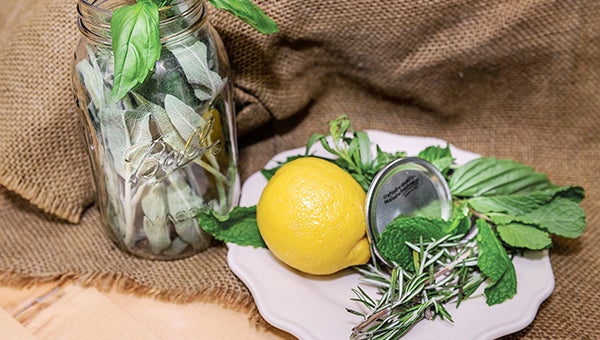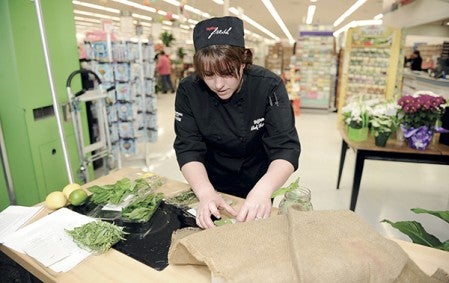Spicing up summer
Published 6:01 am Monday, April 25, 2016

Herbs are a great way to heighten your dining experience and there is nothing better than growing your own fresh herbs. Eric Johnson/photodesk@austindailyherald.com
Fresh is always better and that includes fresh herbs and seasoning on a good steak or crisp salad.
The best way to achieve the fresh taste is to grow it yourself. A regular, backyard garden is a good place to grow those herbs, but an herb garden can be convenient and simple.
“It’s as fresh as it’s going to be,” said Hy-Vee chef Kristine Wolner. “It’s really cheap as compared to buying them.”
What makes an herb garden even more accessible is you don’t have to be an experienced gardener to create and maintain an herb garden, which is made even more convenient knowing minimal space is required.
It’s an effort that requires some time and a good sun spot.
“It is pretty simple and you don’t need a lot of knowledge,” Wolner said. “I recommend four to six hours of sunlight a day so a good window place, you’re pretty safe.”
Wolner does caution a slow start if you’re a beginner. While the basic idea suggests an easy start-up and maintenance, it’s best to take a steady approach.
“If you are a beginner, starting with a couple herbs in a pot is the way to go,” Wolner said.
Wolner said both basil and parsley are good herbs to start out with along with thyme, rosemary and sage.
The idea of an herb garden, however, goes a little bit further than simply growing your own herbs. It can affect the entire dining experience.
“When you’re taking in the different flavors of basil and parsley, you should always stay open minded,” Wolner said. “Letting your palate change encourages new flavors.”
It can also be about getting outside and using the time as a chance to recharge and relax.
“Just the freshness,” Wolner said. “Taking an afternoon stroll after work, picking your herbs — the accomplishment is a good feeling. It’s more of a culture in your own home.
And if all that isn’t enough to get you started, then there is this added benefit. Herbs like lemon thyme, lavender, lemon balm, basil, lemongrass, catnip, rosemary and garlic are good mosquito repellents.
Getting started
Below are some tips provided by Wolner in starting your herb garden.
•If you are a beginner, use small pots that are able to drain. Herbs have short roots so you can get away with using small shallow pot. If going big, make sure the container can drain any access water or you will have issues. This pertains more to rosemary, basil, oregano and thyme. Herbs such as parsley, chives, marjoram and mint can be placed in a draining pot, but also thrive in a self-watering pot, or a pot with no drainage and can make these particular herbs easier to care for — no watering every single day.
•Always fill pots full and tight together and remember the more you trim the more they will grow. Keeping them trimmed, especially when bunching herbs together, will keep them from overcrowding each other.
•When trimming herbs, do not cut them all the way down. Pinch them. Take what you need and don’t forget the more you pinch the better it is for them.
•If you are going to put herbs in the same pot, make sure they have the same requirements. Some prefer it dry and warm while others need to be moistened on a daily basis. Depending on what you wish to grow, research may have to be done to determine what herbs will pot well with others.
•It is great and convenient to combine more than one herb in a pot, depending on how much you use the herbs. If you don’t use a lot of a few different herbs, combine them so you don’t have 50 pots around your home.

Hy-Vee Chef Kristine Wolner arranges herbs inside the store. Wolner is very supportive of the idea of people growing their own herbs at home. Eric Johnson/Austin Living
Filling your garden
•If you are looking to grow mass amounts for winter dry stock, gardening herbs is your best option.
•The downfall to gardening herbs is mainly all herbs need that six or more hours of sunlight and watering feature may be different.
•If you are in a warm area where temperatures get to 90 degrees ore more for a long period of time, this will make the plants suffer so try to find spot that is morning sun and afternoon shade for best results.
•Spacing is important so make sure to read what is suggested on the instructions.
•When preparing soil, there are two things to remember: Make sure the ground is nice and loose. Make this happen by using a tool such as a pitchfork to really turn up the soil for good drainage. Make sure if you are going to use compost, place just under the first layer of soil.
•Harvesting is the same as potting plants. Pinch off chunks, with having the benefits of larger plants you are able to take more off for hanging.






